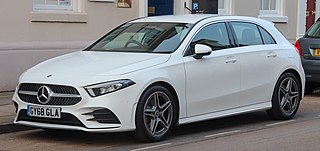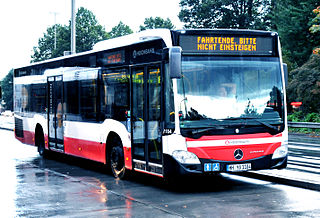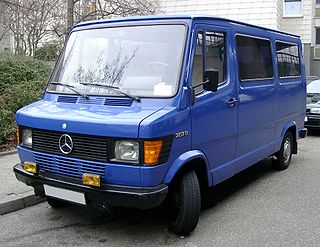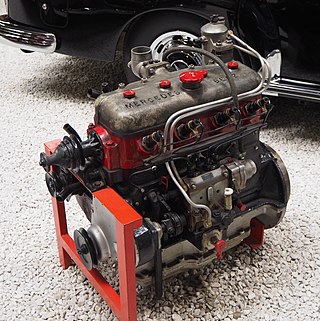
The Mercedes-Benz A-Class is a subcompact car produced by the German automobile manufacturer Mercedes-Benz as the brand's entry-level vehicle. The first generation was introduced in 1997, the second generation (W169) in late 2004 and the third generation (W176) in 2012. The fourth generation model (W177), which was launched in 2018, marked the first time the A-Class was offered in the United States and Canada. This fourth generation A-Class is also the first to be offered both as a hatchback (W177) and sedan (V177).

The Mercedes-Benz Sprinter is a light commercial vehicle (van) built by Mercedes-Benz Group AG of Stuttgart, Germany as a large van, chassis cab, minibus, and pickup truck. In the past, the Sprinter had been sold under the Mercedes-Benz, Dodge, and Freightliner nameplates. In the U.S., it was built from complete knock down (CKD) kits by Freightliner. Re-badged and re-engined Sprinters were also sold by Volkswagen Commercial Vehicles as the Volkswagen LT and the Volkswagen Crafter. They are now primarily marketed by Mercedes-Benz.

The Mercedes-Benz Citaro is a single-decker, rigid or articulated bus manufactured by Mercedes-Benz/EvoBus. Introduced in 1997, the Citaro is available in a range of configurations, and is in widespread use throughout Europe and parts of Asia, with more than 55,000 produced by December 2019.

The Mercedes-Benz W123 is a range of executive cars produced by German manufacturer Mercedes-Benz from November 1975 to January 1986. The W123 models surpassed their predecessor, the Mercedes-Benz W114, as the most successful Mercedes, selling 2.7 million units before production ended in the autumn of 1985 for the saloon/sedan versions and January 1986 for coupés and estates/station wagons.

Mercedes-Benz has been producing buses since 1895 in Mannheim in Germany. Since 1995 Mercedes-Benz buses and coaches is a brand of EvoBus GmbH, a wholly owned subsidiary of Daimler Truck.

The Mercedes-Benz W126 is the company's internal designation for its second generation S-Class, manufactured in sedan/saloon (1979–1991) and coupé (1981–1990) models, succeeding the company's W116 range. Mercedes introduced the 2-door C126 coupé model, marketed as the SEC, in September 1981. This generation was the first S-Class to have separate chassis codes for standard and long wheelbases and for coupé (C126).

The Mercedes-Benz W140 is a series of flagship vehicles manufactured by Mercedes-Benz from 1991 to 1998 in sedan/saloon and coupe body styles and two wheelbase lengths. Mercedes-Benz unveiled the W140 S-Class at Geneva Motor Show in March 1991 with sales launch in April 1991 and North American launch on 6 August 1991.

A midibus is a classification of single-decker minibuses which are generally larger than a traditional minibus but smaller than a full-size single decker and can be anywhere between 8 metres and 11 metres long. While used in many parts of the world, the midibus is perhaps most common in the United Kingdom, where operators have found them more economical, and to have a sufficient number of seats compared to full size single-decker buses.

The Mercedes-Benz OC 500 LE is a modular, heavy-duty, twin-axle bus chassis produced by Mercedes-Benz/EvoBus Ibérica, Spain. It was designed as a modular platform for low-entry city, suburban, and intercity buses with a maximum gross vehicle weight of 19.1 tonnes. The main modules consist of: driver's pedestal, front axle, buggy centre section, drive axle and engine. It has much in common with the chassis used for the Mercedes-Benz Citaro integral bus range, and also the raised floor OC 500 RF coach chassis. The engine is horizontally mounted over the rear overhang.
The Mercedes-Benz MB100 is a light commercial cabover van (M) made by Mercedes-Benz España S.A. from 1981 to 1996 at their Vitoria-Gasteiz factory in northern Spain. The third generation model was manufactured by SsangYong alongside the rebadged SsangYong version from 1995 to December 2003 in South Korea, with another rebadged variant manufactured by Maxus of SAIC Motor from 2009 to 2014 in China.

In 1977 Mercedes-Benz introduced a new van/truck, called T1 internally. Other designations were series TN / T1N and Bremer Transporter, since the vehicle was built in the Transporter-Plant in Bremen, Germany, first. In the years 1983/1984 production went - piece by piece - to the Transporter-Plant-Düsseldorf. The internal chassis-designations are: 601, 602 and 611.

The Mercedes-Benz T2 is a semi-bonneted light commercial vehicle that was manufactured by Daimler-Benz. The T2 is also known as the "Düsseldorf Transporter", since it was built in Düsseldorf from 1967 to 1986. The third generation, built from 1996 at Ludwigsfelde, was branded the Mercedes-Benz Vario.

The Mercedes-Benz Vito is a mid-sized light commercial vehicle (LCV) produced by Mercedes-Benz, available as a panel van, chassis cab, or multi-purpose vehicle (MPV), carrying cargo or up to eight passengers. In the Mercedes-Benz van lineup, it is positioned between the larger Sprinter and the smaller Citan.

A single-decker bus or single-decker is a bus that has a single deck for passengers. Normally the use of the term single-decker refers to a standard two-axled rigid bus, in direct contrast to the use of the term double-decker bus, which is essentially a bus with two passenger decks and a staircase. These types of single-deckers may feature one or more doors, and varying internal combustion engine positions. The majority of single-deckers have a length of up to 12 metres, although some exceptions of longer buses exist. They also typically weigh between 11 and 14 tons.
Mercedes-Benz, commonly referred to as Mercedes and sometimes as Benz, is a German luxury and commercial vehicle automotive brand established in 1926. Mercedes-Benz AG is headquartered in Stuttgart, Baden-Württemberg, Germany. Mercedes-Benz AG produces consumer luxury vehicles and commercial vehicles badged as Mercedes-Benz. From November 2019 onwards, Mercedes-Benz-badged heavy commercial vehicles are managed by Daimler Truck, a former part of the Mercedes-Benz Group turned into an independent company in late 2021. In 2018, Mercedes-Benz was the largest brand of premium vehicles in the world, having sold 2.31 million passenger cars.

The Mercedes-Benz GLC is a compact luxury crossover SUV introduced in 2015 for the 2016 model year that replaces the GLK-Class. According to Mercedes-Benz, it is the SUV equivalent to the C-Class. Although officially considered compact, it is considered mid-size in the US market.

The Mercedes-Benz L 319 is a light commercial vehicle built by Mercedes-Benz between 1955 and 1967. Larger than a standard delivery van, but smaller than a conventional light truck of the period, it was the manufacturer's first model in this class. The vehicle was offered with a range of van and truck bodies. Special application and minibus variants were also available.

The Mercedes-Benz 170 S is a luxury car which was produced by Mercedes-Benz from 1949 until 1955 in various gasoline and diesel powered forms. It was initially offered with a 1.8 liter version of the 1.7 liter inline-four cylinder M136 engine used in the slightly smaller production type 170 V. It was the first Mercedes-Benz to carry in its name the suffix “S” (for Sonder modell denoting a superior level of comfort and quality. As such, its intended market was successful business owners and company directors.

The Mercedes-Benz OM 138 is a diesel engine manufactured by Daimler-Benz. In total, 5,719 units were produced between 1935 and 1940. It was the first diesel engine especially developed and made for a passenger car. The first vehicle powered by the OM 138 was the Mercedes-Benz W 138. The light Mercedes-Benz trucks L 1100 and L 1500 as well as the bus O 1500 were also offered with the OM 138 as an alternative to the standard Otto engine.

Mercedes-Benz Argentina S.A.U. is the Argentine subsidiary of international conglomerate Mercedes-Benz Group which produces and markets Mercedes-Benz utilitary vehicles in the country. The company was established in 1951 and has its assembly plant in Virrey del Pino, La Matanza Partido, where trucks and buses has been produced. Furthermore, MBA imports a wide range of luxury automobile models including sedans, SUVs, and AMG Performance cars.




















